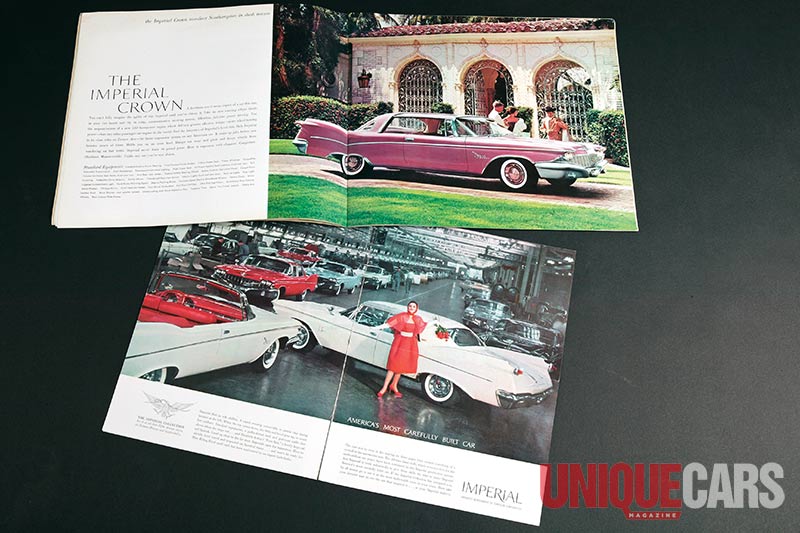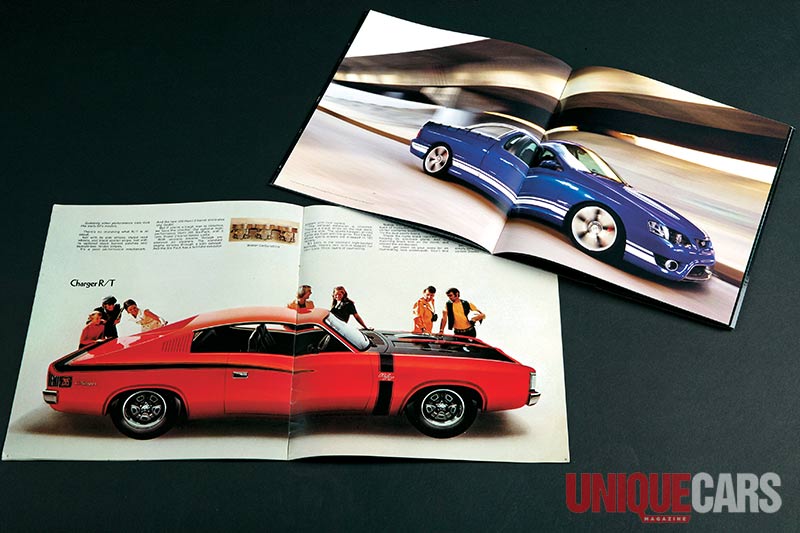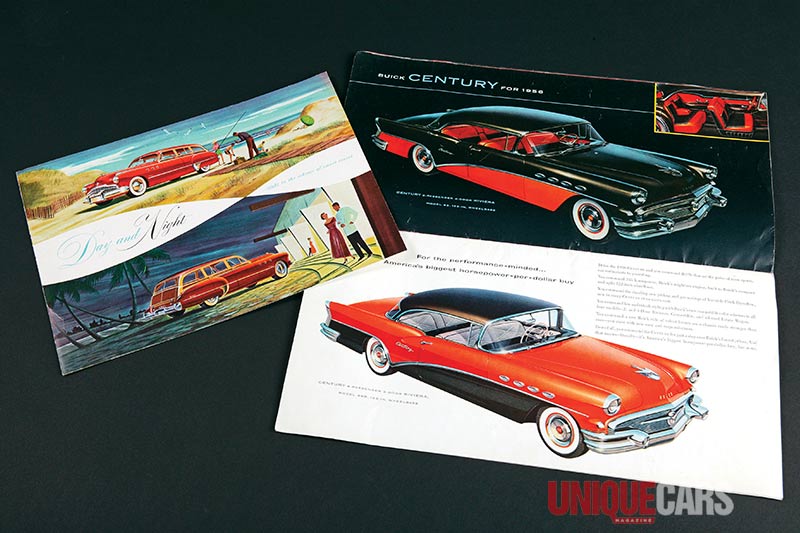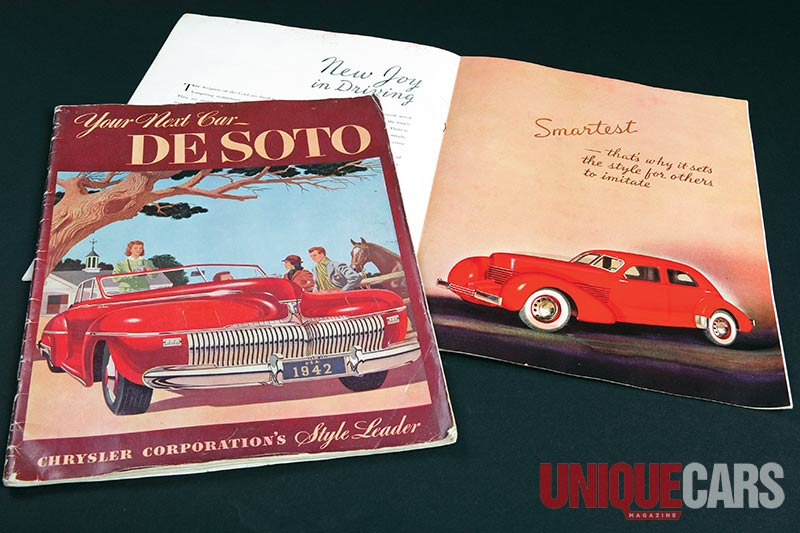Rare Retro Classic Car Brochures



























|

|

|

|

|

|

|

|

|

|

|

|

|
There's life in the traditional car brochure yet
First published in Unique Cars issue #271, Mar/Apr 2007
PAGE TURNERS
Most car enthusiasts can remember the first time they encountered the magic of a car brochure. It was usually the day when a particular car went from being a collection of parts to a passport to another world. Yet it was not always the fanciest cars that came with the fanciest brochures. After cars evolved from a simple catalogue item to a promise of dreams and fantasy, brochures evolved to a new level. As the internet takes over as the new point of contact with prospective buyers, will today’s car brochures mark the end of an era?
My first encounter with a car brochure was nothing fancy. At a time when many Australians were still buying their first car ever, I came home from the 1957 Melbourne Motor Show in a new blue and yellow Harris train clutching a full colour brochure for the Morris 1000 version of the Minor. It is still in my collection but there is not much left of it after it has been opened and closed so often. It wasn’t the humble Morrie that kept me spellbound as a four-year old but the varied new world and brightness that the brochure communicated.

This splash of colour was directly proportional to the familiarity of the subject. The Morris Minor had changed little since 1948. By 1957, most cars had adopted the latest three box shape with integrated guards and wraparound one-piece glass including most other Morris models. The humble Minor was still very much a 1940s child yet it remained one of BMC’s (British Motor Corporation) best hopes for exports.
| Feature: Classic car ads pt.1
A new over-head valve Austin engine with a whopping 948cc (the previous one was 803cc), one-piece windscreen and large rear window was enough to send the Morris spin doctors into warp drive and convince buyers in European national dress, African safari gear and middle-of-the-road Anglo Saxon couples that the Morris 1000 was the car that both he and she would want.

With the back seat filled with two kids and a dog, it depicted a colourful league of nations and both genders living in harmony as long as they all drove a Morris 1000.
How different might the world have been 50 years later if everyone still drove a Morris Minor. It was seductive but universal, practical imagery for war-weary buyers around the world that even a four-year old could understand. It must have been effective when the same Minor continued into the 1970s.
This post-WWII era marked a change from the stark, beautiful illustrations of cars on their own that filled earlier brochures. Because the printing of colour photography was still in its infancy, the illustrators could not only extend, distort or change the proportions of the car, they could now change the scale of its background to generate whatever impression the manufacturer wanted.
As a car changed from a one-off purchase that you kept until it wore out, brochures began to chart a shift in lifestyles and prosperity to keep buyers coming back. There is a clear point where this occurred in the US but it took another 10 years to reach Australia. The arrival of the Japanese consolidated this process when there was very little in the Japanese streetscape that was aspirational for Western tastes.

The 1960 Imperial brochure from Chrysler was a milestone example where a brochure had to establish a selling premise way beyond a transport role and generate an aura that would lift a new Imperial into Cadillac and Lincoln territory. It was not unlike the challenge that faced Lexus decades later. The Imperial had to sit comfortably with the most opulent and elite that the richest nation in history could produce. It was a huge challenge that required new strategies.
Chrysler sterilised the Imperial production line into something that resembled a hospital environment. The company then invited the women from Vogue to enhance it, as if to validate the credentials of the squeaky clean factory. High quality still photography gave it extra credibility. The inference was that Imperial buyers were beyond buying a car that emerged from the bowels of noisy, dirty work pits. The co-branding of Vogue and Imperial was possibly the first when the link was made inside a factory, not some esoteric lifestyle location.
Lincoln then pictured its models with classy designer items. Ford developed a strong aero theme with the Thunderbird and its overhead controls. It was around this time in 1965 that Australian manufacturers moved from renderings of the cars combined with library photo shots of Australian landscapes to real Aussie photos featuring both the cars and ackground. It marked a time that the Australian dream no longer had to be defined by Americans or Europeans. A memorable stream of credible brochures followed.
Although Ford’s XP Falcon brochure started it, the XR Falcon brochure is an Australian milestone using Australian aspirations to reinforce the new Falcon’s cut-above positioning. It was a crucial change when Ford had to lift its big new Falcon clear above Holden and Chrysler’s Valiant, as well as present a case for graduating to a Fairmont and a selection of engines that included Australia’s first V8 option across the range.

Chrysler retaliated with a new brochure format for its VE Valiant in 1967, again for the first time, using real life photos of car and scenery to show how the Australian dream could be achieved while driving a VE Valiant. It worked after these later Valiants became the car of choice for upwardly mobile migrant Australians.
Holden had little choice but to follow with its benchmark HK series brochure in 1968 with its stunning open road shots and activity scenes that reinforced why Holden was still Australia’s Own car. Although the base HK Kingswood wasn’t up to much in standard form, the HK series was the start of the options game and the brochure went into overdrive to convince buyers to spend more on defining their version of the dream. A memorable Monaro brochure accompanied it.
Later Statesman, Fairlane, LTD and Chrysler VIP brochures highlighted how quickly these aspirations had risen in a remarkably short time.
The Japanese were still some years away from this process. Mazda, like most Japanese manufacturers, had evolved from a quaint importer to a legitimate part of Australian life. It was on my watch in 1985 that Mazda brochures shifted from carefully neutralised scenery and models of Eurasian appearance to full Australian lifestyle photos of the cars, people and scenery to reflect the greater local input in the final specification.

To justify a price premium over local rivals, the lifestyles and scenery were established a full class above the brochures for the same cars that wore a Ford badge. The brochures were an important component in keeping the two model ranges apart.
The Europeans took a very different approach, either letting the car speak for itself or picturing it in home territory to reinforce its specialist origins. Mercedes-Benz unashamedly still highlights its German content and approach while Jaguar allows the British scenery do the talking.
The Daimler 2.5-litre brochure of the early 1960s was an outstanding example of a brochure with a product focus.
It featured a metal clasp shaped like the grille, the main external feature that distinguished it from the almost identical Jaguar MkII.

Brochures of exotic Italian cars let the styling and mechanical specifications take centre stage and leave it to the buyer to dream about who they are going to impress and where they intend to use the horsepower. Without this pedigree, the rare DeLorean brochure highlighted the credentials of the man behind it and those who styled and engineered it.
That’s the key to the best brochures. They are a personal communication between the people who designed and built the car and the buyers they were intended for. Done well, they can be a sales tool that continues working long after the buyer has left the showroom. Most car companies prepare sales manuals that reinforce the message in the brochure.
For some of the more exotic low volume examples, the brochure is often the main selling tool. They are not cheap. Most full colour brochures today end up costing someone, somewhere in the selling chain anything from $7-25 each. They stand forever as a reference as to how the car was specified and the context it was designed for hence brochures for some of even the most humble models can quickly top $500 if they are rare and sought after.

One of the big changes in recent times is the separation of specifications and equipment from the main brochure with the insertion of a single colour-printed sheet. Under tough new consumer laws, manufacturers cannot afford to scrap print runs of glossy colour brochures if the cars are forced to leave the factory not exactly as described in the brochure. As more manufacturers delete features out of their brochures, they lose some excitement as the words and images become less specific.
So is it the beginning of the end for the car brochure? A quick survey of seasoned new car sellers suggests not. Although buyers are using the internet in record numbers to research and narrow their new car choices, the brochure is still a critical tool that allows the sales pitch to go home with the prospective buyer and for the dreams to begin.
Unique Cars magazine Value Guides
Sell your car for free right here
Get your monthly fix of news, reviews and stories on the greatest cars and minds in the automotive world.
Subscribe

.jpg)













